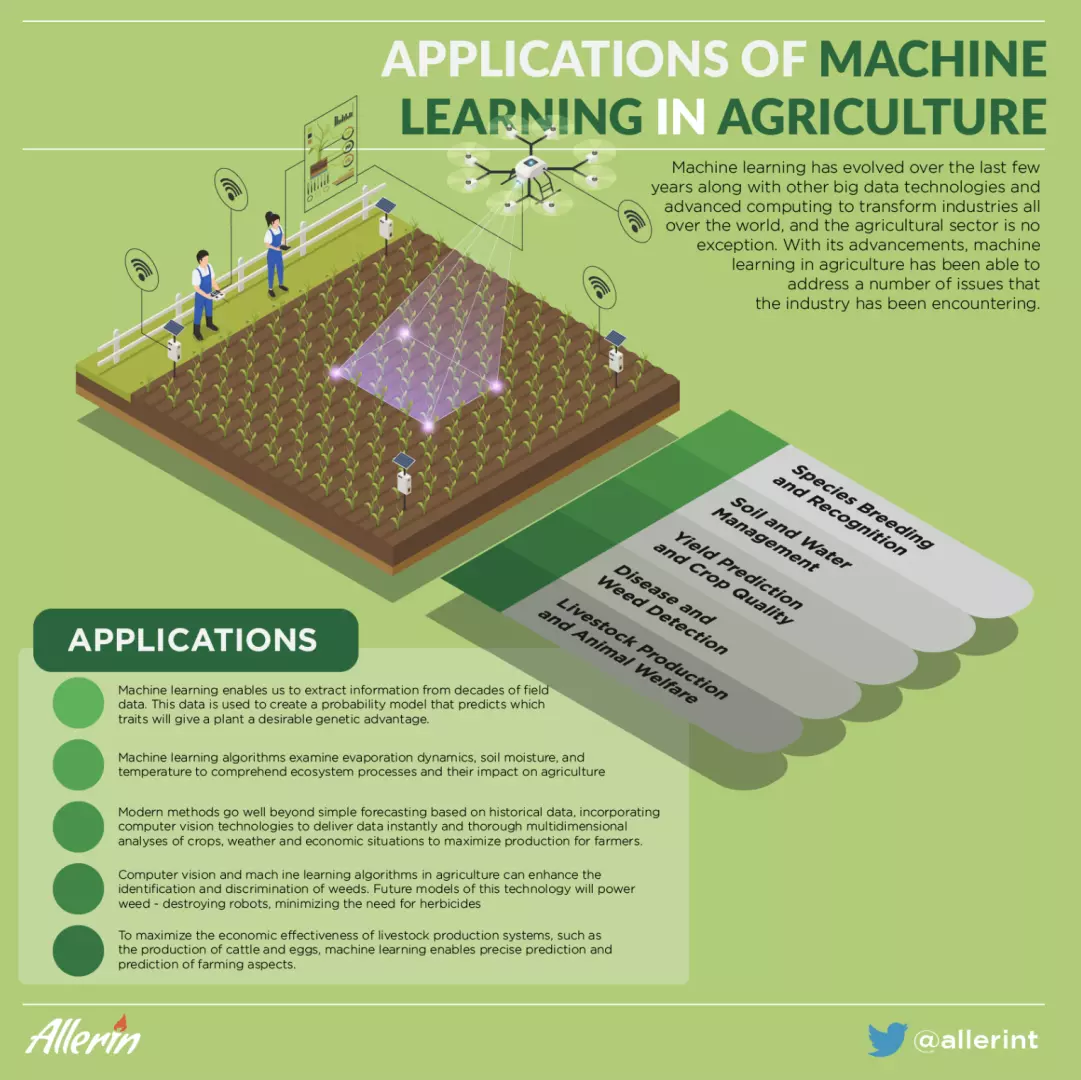Comments
- No comments found

Machine learning has evolved over the last few years and the agricultural sector is no exception.
With its advancements, machine learning in agriculture has been able to address a number of issues that the industry has been encountering.
Businesses can achieve success only when they constantly outperform their rivals in decision-making, and the agricultural sector is no exception. Through machine learning in agriculture, farmers now have access to more advanced data and analytics tools, facilitating better decisions, increased productivity, and decreased waste in the production of food and fuels, all while reducing unfavorable environmental effects.
With the assistance of highly precise algorithms, the growing idea of "smart farming" boosts the efficacy and productivity of agriculture. Machine learning — a branch of science that allows machines to learn without being explicitly programmed — is the mechanism behind it. To open up new possibilities for unraveling, analyzing, and comprehending data-intensive processes in agricultural organizational settings, it has evolved in tandem with big data technologies and powerful computers. Farmers can now predict agricultural yield and evaluate crop quality, determine plant species, and diagnose plant diseases and weed infestations at seemingly unimaginable levels, using sensors in the farm in accordance with ML-enabled electronic innovations. Throughout the entire cycle of planting, growing, and harvesting, machine learning in agriculture is prominent. It starts with sowing a seed, goes through soil testing, seed breeding, and water supply measurement, and concludes with robots collecting the harvest and using computer vision to assess its degree of ripeness. The amount of data accessible to farmers today is overwhelming without the aid of machine learning technology. Lots of data can be promptly assessed by ML, with the help of which it recommends the most profitable strategy. For instance, it can advise on when to plant in order to ward off pests and diseases. The advantages of digital farming are legitimate; it may assist growers in making the best input decisions in order to enhance production and profit. Furthermore, it can assist farmers in determining actual expenses on a field-by-field basis rather than only on a farm-wide one.
Machine learning has extensively grown in the agricultural sector in recent years. Following are its applications in the farming industry:

The laborious process of species selection entails looking for particular genes that will guarantee efficient responsiveness to water and nutrients. Ideal plant species will be able to withstand climatic change, be disease-resistant, have more nutrients, and taste better.
For a thorough investigation of crop performance, machine learning enables us to extract information from decades of field data. This data is used to create a probability model that predicts which traits will give a plant a desirable genetic advantage.
Species identification in crops has typically been carried out using straightforward comparisons, such as the color and shape of the leaves. Utilizing more advanced approaches, such as assessing leaves with the help of vein morphology, machine learning allows us to evaluate plants in a way that is much more sophisticated, accurate, and quick.
Machine learning algorithms examine evaporation dynamics, soil moisture, and temperature to comprehend ecosystem processes and their impact on agriculture.
The deficiencies in the soil can be taken care of by ML strategies. For example, machine learning technologies can help farmers maintain optimal amounts of inorganic nitrogen. The nitrogen cycle in the soil and the environment is predicted through nitrogen modeling, which directs the farmer to optimum levels. Software simulations can detect whether nitrogen is available and determine when to add nitrogen to the soil. On the other hand, it can notify the farmer when there is too much nitrogen present, which might damage the crops.
The use of irrigation systems can be made more efficient too, thanks to ML-based applications that estimate daily, weekly, or monthly evapotranspiration and predict the daily dew point temperature, which aids in predicting expected weather events and calculates evapotranspiration and evaporation.
One of the most significant and well-known areas of precision agriculture is yield prediction, which encompasses mapping and assessment of yields, matching crop supply and demand, and crop management. Modern methods go well beyond simple forecasting based on historical data, incorporating computer vision technologies to deliver data instantly and thorough multidimensional analyses of crops, weather and economic situations to maximize production for farmers and the public at large.
Accurately identifying and categorizing agricultural quality attributes can raise product prices and minimize wastage. In contrast to human specialists, machines can employ seemingly pointless data and connections to expose and discover new attributes that contribute to the overall quality of crops.
Significant amounts of pesticides must be sprayed over the crop area to combat disease, which frequently has a high financial cost and a considerable environmental impact. When using general precision agriculture management, ML is used to target the application of agrochemicals based on the time, location and plants that will be affected.
Weeds pose a serious threat to the growth of crops. Weeds are tricky to identify and distinguish from crops, which presents the biggest challenge in weed control. With minimal expense and no negative effects on the environment, computer vision and machine learning algorithms in agriculture can enhance the identification and discrimination of weeds. Future models of this technology will power weed-destroying robots, minimizing the need for herbicides.
To maximize the economic effectiveness of livestock production systems, such as the production of cattle and eggs, machine learning enables precise prediction and prediction of farming aspects. For instance, 150 days before the day of slaughter, weight prediction systems can anticipate future weights, enabling farmers to adjust their diets and environmental factors accordingly.
Today's livestock is increasingly viewed as animals who can be unhappy and worn out by their life on a farm rather than just as food carriers. Animals' movement patterns, such as standing, moving, eating, and drinking, can determine how much stress an animal is exposed to and forecast its susceptibility to diseases, weight increase, and productivity. Animals' chewing signals can be linked to the need for food adjustments.
Agricultural machine learning is not some enigmatic gimmick or magic; rather, it is a collection of well-specified models that gather particular data and employ methodological approaches to get the desired outcome.
Artificial Neural Networks (ANNs) and Support Vector Machines (SVMs) are two very popular machine learning models being utilized for agriculture.
ANNs are models of biological neural networks that mimic complex activities like pattern production, reasoning, learning and judgment. They are inspired by how the human brain functions.
SVMs are binary classifiers that divide data instances into categories using a linear separation hyperplane. Clustering, regression and classification are all performed using SVMs. They are utilized in farming to estimate animal production and crop productivity and quality.
Additionally, Farmer's Chatbots are now under development. Instead of just providing numbers, these would be able to evaluate the data and consult farmers on complex issues, and hence are predicted to be even smarter than consumer-oriented Alexa and similar assistants.
Machine learning breakthroughs have incredible potential, much like software. Agriculture scientists are putting their theories to the test on a larger scale and assisting in the development of more precise, real-time prediction models pertaining to crops. Machine learning in agriculture has the capacity to provide even more solutions for sustaining the world's population, coping with climate change and conserving natural resources.
Currently, machine learning solutions focus on specific issues, but as automated data collection, analysis, and decision-making are further integrated into a connected system, many farming activities will change to what is known to be knowledge-based agriculture, which will be able to boost output and product quality.
Naveen is the Founder and CEO of Allerin, a software solutions provider that delivers innovative and agile solutions that enable to automate, inspire and impress. He is a seasoned professional with more than 20 years of experience, with extensive experience in customizing open source products for cost optimizations of large scale IT deployment. He is currently working on Internet of Things solutions with Big Data Analytics. Naveen completed his programming qualifications in various Indian institutes.
Leave your comments
Post comment as a guest